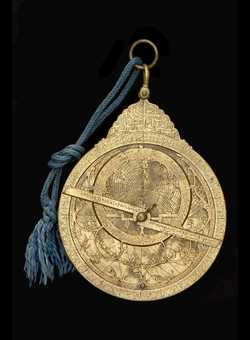| Date | early 18th century |
| Maker | ‘Abd al-A’imma |
| Place | Iṣfahān |
| Material | Brass |
| Inventory no. | 40833 |
| Acquisition | Presented by J. A. Billmeir in 1957 |
Unique in the collection is the astrological gazetteer engraved on to one of the tympans of this astrolabe. Gazetteers are common features of Islamic astrolabes and usually contain a list of important cities with their longitude and latitude. The tympan shown in the picture, however, contains two concentric lists of cities, engraved against a stippled background, and the zodiacal sign and planet (occasionally planets) that influence each city.
There is ample precedence for the system of geographic astrology represented by this astrological gazetteer. Indeed, Claudius Ptolemy, the greatest astronomer and astrologer from antiquity, had presented in his Tetrabiblos a detailed scheme for relating geographical locations to both planets and zodiacal signs. Embedded in Ptolemy's scheme was a rational method for dividing the world into regions by correlating the characteristics associated with a planet to those commonly applied to people from different cities and countries. This allowed later astrologers to extend and adapt Ptolemy's method to fit their own needs.
By the ninth century Arab astronomers, notably Abu Ma‘shar, had appropriated and extended Ptolemy's system of geographic astrology. The astrological gazetteer on this astrolabe suggests that the owner of the instrument anticipated using it alongside tables of planetary ephemerides, for the astrolabe itself does not indicate the positions of the planets. Further, the gazetteer testifies to the longevity of Ptolemy’s practice of dividing the earth into regions according to the zodiacal signs and planets that influenced those regions.
View all
images for this astrolabe
View
detailed provenance for this astrolabe
Mater
The mater and limb are of one-piece construction. The tab that holds the tympans in place is located at the bottom of the instrument, 180° from the throne. Scales on the limb: degree scale.The limb is inscribed: with a marked as [along edge of limb]. [ pending ]. More information
Back
The back contains 16 scales of the following types: Altitude; Declination; Azimuth of Qibla; Altitude of noon sun; Sine/Cosine; Cotangent; Terms; Zodiacal signs; Faces; Lunar Mansions; Shadow square; Triplicities. The back is inscribed: with a miscellaneous marked as غرض نقشيست كه تا باز ماند كه هستي را نمى بينم بقائي (The aim of the engraving is that it should remain after me, for I see not the continuity of earthly existence.). Inscription in double cartouche at bottom rim. with a maker's signature marked as صنعه الحقير عبد الائمة (Made by the contemptible ʿAbd al-Aʾimmah.). Inscription in cartouche below shadow square. More informationRete, Pin & Horse
The rete contains 0 stars. The zodiac on the rete is labelled: حمل , ثور , جوزا , سرطان , اسد , سنبله , ميزان , عقرب , قوس , جدي , دلو , حوت.The rete contains 1 scale of the following type: Ecliptic.
The rete is attached using a pin & horse. The horse is simple in design and undecorated. More information
Rules & Alidades
| Type | Details |
|---|---|
| Rule | Double-ended, counter-changed. It is possible that
this rule is a replacement. Islamic astrolabe rarely have
a rule or pointer on the front of the instrument.
Moreover, the silver knob at the bottom of the rete
prevents this rule from rotating around the entire
circle. |
| Alidade | Double-ended. |



